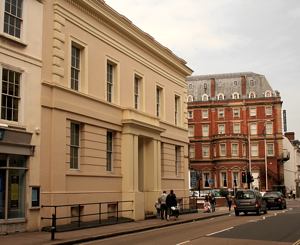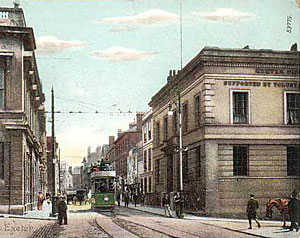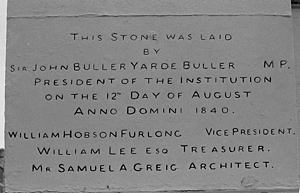
The Exeter Dispensary
Queen Street
Page updated 8th December 2013
Founded in 1818 by Dr Henry Blackall to provide relief for the poor suffering from fevers and contagious diseases, and for children who were unfit to be admitted by the Devon and Exeter Hospital. Premises were rented for £31 per annum on Frienhay Street, and it opened for business in March. Six physicians, six surgeons and three consultant surgeons offered their services for free. It was funded by subscription, with a guinea making the donor a governor of the institution.
Many infectious cases, that would not be be admitted to the Devon and Exeter, were dealt with in the first 9 months of operation. Whooping cough, small pox, dysentery, scarlatina and general coughs and stomach complaints were treated. Patients were admitted at 12 noon each day, on rotation, or visited in their homes. In 1828 9,665 cases were dealt with, and its physicians attended many of the cholera cases in the 1832 epidemic. Dr Hennis who was killed in a duel in 1833, working from the dispensary, laboured tirelessly during the outbreak. Dr Shapter, who chronicled the epidemic in 1848, inaugurated the Devon and Exeter Pathological Society at the dispensary, in the same year.
Queen Street
After several years of searching for a site to build a purpose designed dispensary, land on the corner of Northernhay Street and Queen Street, opposite the City Prison, now the Rougemont Hotel, was acquired from the City Council.
The foundation stone was laid on 12th August 1840. On the day, the Cathedral bells were rung for what was thought to be a 'most useful charity'. Members of the Governors, Subscribers and other worthies met at Congdon's Subscription Rooms (The Royal Subscription Rooms) and walked in procession to the Cathedral for a service. After the service, they then walked, accompanied by a band, to the site for the new building. The Portland stone was raised into position, and then a silver trowel was handed to Sir John Buller who proceeded to spread a quantity of mortar, burying inside a half-crown, shilling, and a sixpence. After all the usual speeches, there was a royal salute fired by General Mortimer's Fort Barbican Battery, brought from Plymouth for the occasion. They all then retired to dine at the Globe Hotel. The workmen were treated to a dinner at the Turk's Head Inn, in the High Street.
The building, designed by Mr S A Greig, was opened in 1843 and cost £2,300 The two storey building has a stucco frontage on both Queen Street and Northernhay Street, and rusticated quoins on the first floor. The entrance door has coupled Doric pilasters and a balustraded parapet. There is a dentil cornice running along the visible sides of the building. The building is typical of many Victorian, urban buildings that can be found in many towns. Using stucco was cheap in comparison with stone, and pseudo Doric pillars and decorated quoins could be incorporated, for little extra cost, giving the building an air of grandeur. It could be said to be municipal Classical light.
The Dispensary remained open during the 1849 outbreak of cholera, and a thousand cases of diarrhoea were treated in the same year.
In 1896, the hospital was altered to allow accommodation for one nurse. Most cases were treated as outpatients as accommodation was very limited. The rather attractive building became offices for the NHS towards the end of the 20th Century, before the Exeter College occupied the building at the start of the 21st century, for music and performance courses.
Grade II listed 18 June 1974.
Sources: Plymouth and Exeter Gazette,Flying Post and British Listed Buildings.
 Exeter Dispensary in Queen
Street, 1908.
Exeter Dispensary in Queen
Street, 1908. Exeter Dispensary in Queen
Street, 1908.
Exeter Dispensary in Queen
Street, 1908. The foundation stone.
The foundation stone.
│ Top of Page │